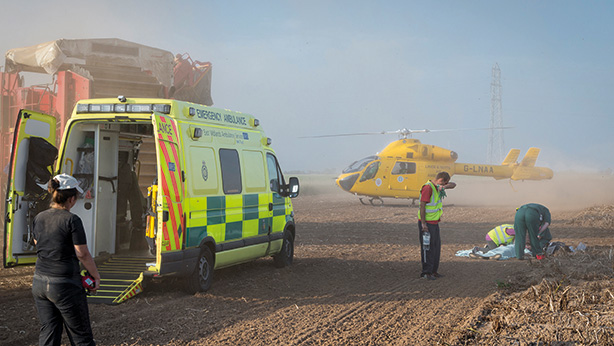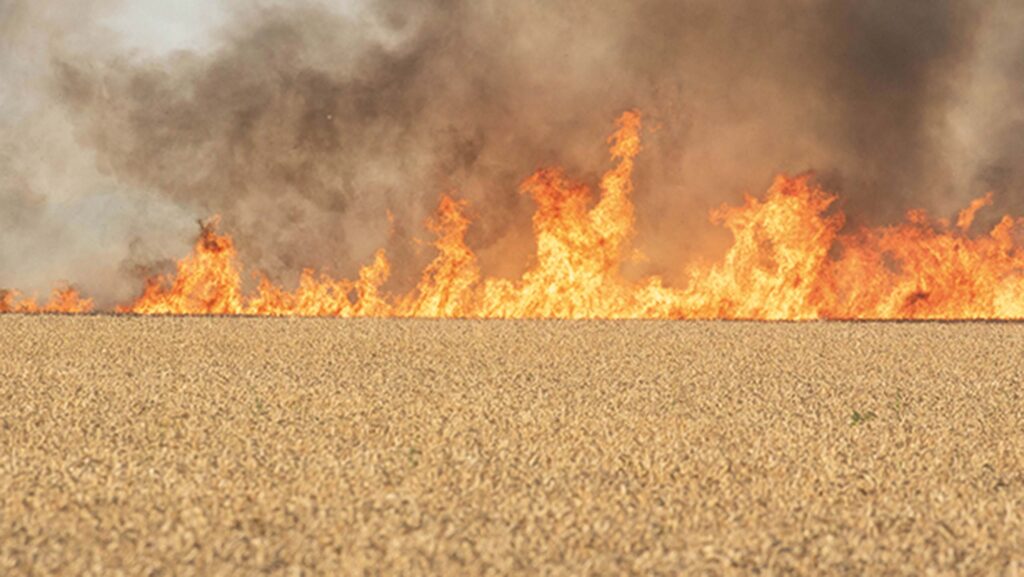Improving farm safety and saving lives
 © GNP
© GNP The statistics around farm fatalities and workplace injuries are truly sobering.
Agriculture, forestry, and fishing had a fatal injury rate last year which was 21 times higher than the national average, according to the Health and Safety Executive (HSE).
The sector also had the second highest number of fatalities of any industry, and the highest percentage of non-fatal workplace injuries at roughly 9,000 – equivalent to 3,730 for every 100,000 agricultural workers.
See also: Farm safety – is there a level playing field for women?
Speaking at a farm safety day in Leicestershire, Phillip Smith, senior health and safety consultant at NFU Mutual Risk Management Services, feared the situation could be far worse than the figures show.
“I read an HSE paper suggesting that 95% of all serious accidents across industry get reported under the Reporting of Injuries, Diseases and Dangerous Occurrences Regulations, but that this figure could be as low as 17% in agriculture,” he said.
Yet a number of easy measures can be put in place on-farm to improve safety, reduce these figures and drive the industry forward.
Maintenance
All farm equipment should be safely maintained, serviced, and in good working condition in order to meet HSE regulations, Mr Smith advised.
Farm managers should make a risk-based decision on which bits of kit need checking as a priority, and look at which equipment would injure someone if it went wrong, such as a feed mixer, straw chopper, or pto shaft on a tractor.
The use of Tilly Trailer tests is also recommended. If this is not possible, farm businesses should at least ensure the brakes get tested on-farm, using the manual as a minimum.
Reading equipment manuals is also advised to make sure people know how machinery works, and staff should keep a record that this has been done.
Mr Smith said: “Different people have different training needs. Treat them like adults and give them the right training they need for a specific bit of kit, and get them to sign something to say they have done it.”
Moving vehicles
Convex mirrors on the corners of buildings can provide a simple, cheap way to improve visibility on-farm that helps the entire staff.
A further recommendation is to use a map to mark where farm buildings are and where vehicles and pedestrians typically move. Where vehicles and pedestrians cross, farmers should take additional measures.
One solution already being implemented by some larger businesses in the fresh produce sector with high staffing numbers is to implement set time periods for vehicle movements, and then provide specific timed breaks for workers to cross on foot.
Mr Smith said: “Around 60% of all work-related tractor accidents take place when a vehicle is reversing.” Visibility behind tractors is very poor and workers should avoid being within 10m of a reversing vehicle.
Safe Stop practices, which were designed by the agricultural industry to cut the number of deaths, should also be implemented:
- Engage handbrake
- Controls in neutral
- Switch off engine
- Remove key
Mr Smith said there may be some minor exceptions, but stated that if work is being done on any moving parts at all, it needs to be turned off. “You have got to be pragmatic with the way you are working with machinery.”
Slurry lagoons
Slurry pits and lagoons can create several safety risks for farm businesses due to both the gases and the soft, permeable surfaces.
Rob Cross, rural crime officer for Leicestershire Police said: “Emergency services are the first people contacted when something has gone terribly wrong and they need help.
“There was a case where a dog walker’s terrier dropped off the footpath and into a slurry pit. There was crust on the top of the slurry and the walker had gone to get the dog out and fallen straight through.”
The police were contacted, and the walker was close to drowning due to the quicksand-like properties before help had arrived.
Mr Smith said it would be unreasonable to expect a member of the public to naturally avoid a slurry lagoon if they walked off a footpath, so farmers should consider this possibility and take action against it.
Solutions would be to ensure proper fencing around lagoons, positioning the lagoon away from public access and installing slurry covers.
The Farm Safety Foundation advises that if there is an accident or someone collapses in a slurry store, don’t go into any building or store. Stay outside if possible, stop the pump, and contact the emergency services.
Children on farms
HSE guidance states that “farms are not playgrounds”, and suggests that children should be kept away from some of the most dangerous areas, such as chemical stores, slurry pits, sheep dips, grain bins, and machinery.
Mr Smith said: “From 1 January this year, HSE has taken a very strong stance. If you have children on farms and they are in the active work environment, they will now seek to enforce the regulations where children aged 13 and under cannot be on agricultural machinery.
“When I go around farms and they say ‘Oh, I’ve got a sign saying there’s children on-farm’, that is not sufficient. Children are not permitted in the workplace in any other industry sector.”
Insurance claims and fines
Paperwork is also important. If an insurance claim is made on-farm, the insurance company is likely to ask to see any relevant documents related to the work that was being carried out.
Without these documents in place, it can make it much harder to make a claim.
Mr Smith elaborated: “They will want to see an accident book entry, a signed risk assessment, a signed system of work, and a signed safety policy, among other documents.”
He added: “We are seeing a greater number of larger fines handed to farms by HSE, which is unsurprising given the number of serious accidents that happen in agriculture.
“If you have a fatality on farm today, you are potentially going to end up in the courtroom.”
Other safety considerations
- The Health and Safety Executive (HSE) requires workers to have formal competence qualifications for equipment such as chainsaws, regardless of grandfather rights
- Avoid working at height wherever possible, and, if man cages are used, HSE says workers should be clipped into a harness
- Avoid entering confined spaces such as a grain silo or slurry store. If this cannot be avoided, put a gas detector in before entering a confined space, wear a harness, and don’t work alone
- Create roll away options when working with livestock
- Personal Protective Equipment is important, but use it wisely and correctly. High-visibility vests can get caught. T-shirts and coats with high visibility strips can work well instead
- Share best practices with colleagues and other farmers.
Stay safe this harvest
As harvest approaches, many risks become heightened due to long hours, fatigue and lone working.
NFU deputy president David Exwood said: “Safely operating machinery must be a top priority for every farm business throughout the year. During the busy harvest period, it is more important than ever to not cut corners. Take five minutes to think ahead and plan how to work safely.
“Measures such as making sure machinery and farm transport are in a safe working condition, operators have appropriate training and knowledge of emergency procedures, and using the Safe Stop procedure can all help and ensure everyone goes home at the end of the day.”
Stephanie Berkeley, Farm Safety Foundation manager, added: “Farmers will be under increased levels of stress and pressure this harvest season. It is vital that farmers give themselves the time to consider what could go wrong.
She recommended the following advice:
- Provide extra training for staff
- Ensure all equipment is well maintained, safe, and ready for use
- Share details, including field and yard plans, with staff and contactors so everyone knows the location of hazards such as overhead powerlines
- Keep in regular contact with anyone who will be about.
Fire risk

© Tim Scrivener
Buckinghamshire Fire and Rescue Service encourages farmers to:
- Regularly clean out dust and chaff from hot spots, and check machines over when finishing for the day
- Use a compressor to regularly blow away debris from machines at a reduced exit pressure of 30psi
- Always stop to investigate hot-running engines or bearings
- Have a plan in place in the event of fire, including a system for keeping in contact with lone workers and anyone working or living on-farm
- Keep mobile phones close at all times
- Ensure drivers are aware of the locations and heights of powerlines, and check you will safely pass under wires
- Keep a fire extinguisher on the combine that is regularly maintained
- Keep a bowser filled with water on hand.
